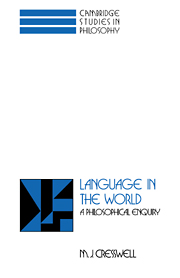Book contents
- Frontmatter
- Contents
- Preface
- Introduction
- 1 A simple formal language
- 2 Predicates and functors
- 3 The isomorphism problem
- 4 Quantification
- 5 Transmundism
- 6 Putnam's ‘Meaning of “meaning”’
- 7 Lewis on languages and language
- 8 Causation and semantics
- 9 Belief–desire psychology
- 10 Direct knowledge
- References
- Index
3 - The isomorphism problem
Published online by Cambridge University Press: 01 October 2009
- Frontmatter
- Contents
- Preface
- Introduction
- 1 A simple formal language
- 2 Predicates and functors
- 3 The isomorphism problem
- 4 Quantification
- 5 Transmundism
- 6 Putnam's ‘Meaning of “meaning”’
- 7 Lewis on languages and language
- 8 Causation and semantics
- 9 Belief–desire psychology
- 10 Direct knowledge
- References
- Index
Summary
The last chapter raised the problem of deciding which interpretation is the correct one. I want now to raise a particular case of what is in fact the same problem. To do this I will take ℒ and pretend that its intended interpretation is extremely small. I shall assume that W contains only two worlds w1 and w2 and that D contains only two individuals, say Adriane and Bruce, whom I shall refer to as a and b. I will assume that, for the interpretation of possibly, w1Rw1 and w1Rw2. That is, each world is possible relative to itself and w2 is possible relative to w1. Assume that a runs in w1 and b runs in w2 while a sees b in w1 and b sees a in w2. I shall ignore whistling. It is convenient to refer to running and seeing as w1 and w2 where
What this means is that the set of worlds in which a runs is just {w1}, i.e. the set whose only member is w1, while the set of worlds in which b runs is {w2}. To state w2 we need the symbol ø, which stands for the empty set, the set which has no members.
Information
- Type
- Chapter
- Information
- Language in the WorldA Philosophical Enquiry, pp. 34 - 48Publisher: Cambridge University PressPrint publication year: 1994
